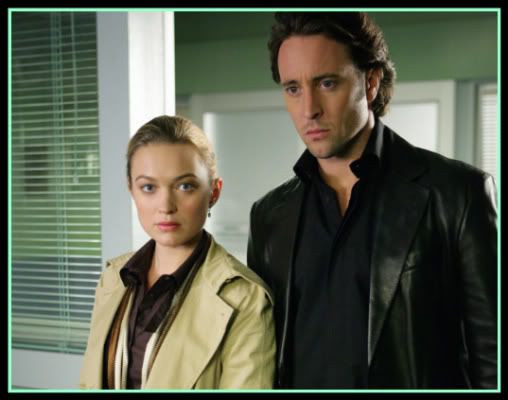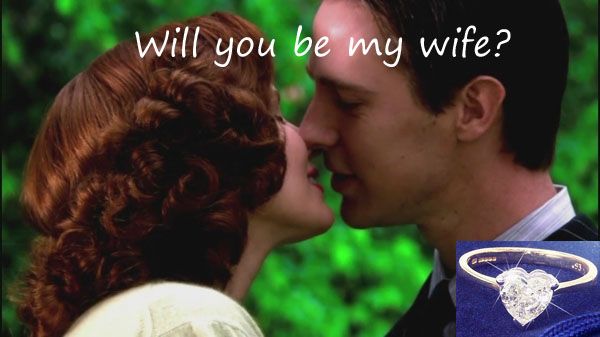Personally, I think they were trying to set up some conflicts for season 2 and they did a sloppy job of it.
Moonlight Episode Discussion - Ep 14: Click
- Lilly
- Moonlightaholic Mod
- Posts: 25472
- Joined: Fri Jan 16, 2009 4:24 pm
Re: Moonlight Episode Discussion - Ep 14: Click
Mick and Beth were always a "team," right from the beginning. He killed (or did serious damage to) a TA to save her. She killed LeeJay to save him. He killed Pollack, the assassin at the No-Star Motel, the teen vamp, Lola, Shepherd, Martan, and (with Josef) took out the 3 vamps at Anders' lab. Why did she feel the need to "protect" him in secret? It's out of character.
Personally, I think they were trying to set up some conflicts for season 2 and they did a sloppy job of it.
Personally, I think they were trying to set up some conflicts for season 2 and they did a sloppy job of it.
Lilly
My Fanfic Index
Avatar from "Matasaburo of the Wind" © 2009 Alex Gross, used with the permission of the artist
My Fanfic Index
Avatar from "Matasaburo of the Wind" © 2009 Alex Gross, used with the permission of the artist
- allegrita
- Moonlightaholic Admin
- Posts: 46393
- Joined: Sat Jan 17, 2009 9:22 am
- Location: Snuggled under the brown afghan, watching the fire
Re: Moonlight Episode Discussion - Ep 14: Click
Well, be that as it may, it's canon.  So I'm trying to fanwank it into some sort of meaningful context in terms of what we know about the characters in the show.
So I'm trying to fanwank it into some sort of meaningful context in terms of what we know about the characters in the show.

-
jen
- Cleaner
- Posts: 6411
- Joined: Mon Apr 20, 2009 12:11 am
Re: Moonlight Episode Discussion - Ep 14: Click
Fanwank.
Interesting word.
Don't think I've ever heard it before, but I like it.
An Alle original?
Interesting word.
Don't think I've ever heard it before, but I like it.
An Alle original?
Mick and Beth--two of the lovely faces of Moonlight

Beautiful banner by the Fabulous Phoenix

Beautiful banner by the Fabulous Phoenix
- allegrita
- Moonlightaholic Admin
- Posts: 46393
- Joined: Sat Jan 17, 2009 9:22 am
- Location: Snuggled under the brown afghan, watching the fire
Re: Moonlight Episode Discussion - Ep 14: Click
Oh, no, I didn't invent it. Here's one of many definitions: http://www.wordnik.com/words/fanwank

-
toria1521
- Freelance freshie
- Posts: 213
- Joined: Sat Feb 07, 2009 10:33 am
Re: Moonlight Episode Discussion - Ep 14: Click
I don't agree with you about this, Lilly.I tend to agree more with MS. Beth was afraid to bring this to Mick since he'd already told her about what happens when a vampire has to leave. Kind of like the Witness Relocation Program, you can never go back, at least within a human life span or two.
toria
toria
- librarian_7
- Forever Moonlightaholic
- Posts: 23481
- Joined: Fri Jan 16, 2009 7:21 pm
- Location: wherever Josef is
- Contact:
Re: Moonlight Episode Discussion - Ep 14: Click
I think there is that, but also...it strikes me as odd, since particularly with the Pollack kill, she saw him take out someone in cold blood who was a threat to the tribe.
On the other hand...people sometimes make decisions that aren't entirely logical. And possibly Beth didn't think through all the ramifications.
Lucky
On the other hand...people sometimes make decisions that aren't entirely logical. And possibly Beth didn't think through all the ramifications.
Lucky
-
jen
- Cleaner
- Posts: 6411
- Joined: Mon Apr 20, 2009 12:11 am
Re: Moonlight Episode Discussion - Ep 14: Click
Beth? Not think something through?
Naaaaaah.
Oh, and about fanwank. Thanks, my vocabulary is duly expanded!
Naaaaaah.
Oh, and about fanwank. Thanks, my vocabulary is duly expanded!
Mick and Beth--two of the lovely faces of Moonlight

Beautiful banner by the Fabulous Phoenix

Beautiful banner by the Fabulous Phoenix
- cassysj
- 100% Moonlightaholic
- Posts: 12990
- Joined: Sat Jan 17, 2009 5:58 am
Re: Moonlight Episode Discussion - Ep 14: Click
I wish I had been at chat last week. Just watching the episode now. This was one of my favorites. The "Dad" talk. Josef & Beth protecting Mick. I also liked the feel of the episode, fast paced paparazzi style. I'm only half done but when Mick told Talbot the anchor was the murder weapon he didn't seem to doubt it. I don't remember, was there a rumor about Talbot being a werewolf?
- allegrita
- Moonlightaholic Admin
- Posts: 46393
- Joined: Sat Jan 17, 2009 9:22 am
- Location: Snuggled under the brown afghan, watching the fire
Re: Moonlight Episode Discussion - Ep 14: Click
That was one of the things Harry Werksman mentioned at the Con, Carol. But I'm pretty sure that CBS nixed the werewolf idea, so they went with the Legion story instead in their second-season pitch.

- cassysj
- 100% Moonlightaholic
- Posts: 12990
- Joined: Sat Jan 17, 2009 5:58 am
Re: Moonlight Episode Discussion - Ep 14: Click
Thanks Alle. Werewolf would have explained why Talbot would have gone along with the anchor thing he may have smelled it as well. He may have known or guessed that Mick was a vampire and wanted to get Beth working with him so he could confirm that.  All the possibilities
All the possibilities
- allegrita
- Moonlightaholic Admin
- Posts: 46393
- Joined: Sat Jan 17, 2009 9:22 am
- Location: Snuggled under the brown afghan, watching the fire
Re: Moonlight Episode Discussion - Ep 14: Click
Here's an interesting bit of trivia that I hadn't noticed before. Remember, when Mick arrives at the Queen Mary for Tierney's "Lusitania" party, he says, in a voiceover: "The last time I saw the Grey Ghost was December 1942. I was with my regiment sailing from New York to England, scared to death. Off the coast of Scotland, we got hit by a 92 ft. wave, almost capsized. Some guy wrote a book about it. He called it The Poseidon Adventure, exaggerated things a bit, but I like to think the Gene Hackman character was based on me."
I never paid attention to that little throwaway line about the Queen Mary nearly capsizing in 1942... but it really did happen, and it really does seem to have been at least part of the inspiration for the book The Poseidon Adventure, by Paul Gallico. Here is a Facebook story, an excerpt from a book called The Power of the Sea, about the rogue wave that nearly capsized the Queen Mary in December 1942, nearly killing 16,000 terrified soldiers (including Mick St. John, at least in the ML-verse).
https://www.facebook.com/ThePoweroftheS ... 57985929:0
I never paid attention to that little throwaway line about the Queen Mary nearly capsizing in 1942... but it really did happen, and it really does seem to have been at least part of the inspiration for the book The Poseidon Adventure, by Paul Gallico. Here is a Facebook story, an excerpt from a book called The Power of the Sea, about the rogue wave that nearly capsized the Queen Mary in December 1942, nearly killing 16,000 terrified soldiers (including Mick St. John, at least in the ML-verse).
https://www.facebook.com/ThePoweroftheS ... 57985929:0
The Queen Mary and the Rogue Wave.
.....On December 8, 1942, a year and a day after the attack on Pearl Harbor brought the United States into World War II, the RMS Queen Mary left New York with over 16,000 American troops heading for Gourock, Scotland, 3,000 miles across the stormy Atlantic. A 1,000 feet long and 81,000 gross tons (cargo volume), she was the fastest ocean liner in the world. She could reach any British port in just five days (compared to two weeks for convoys of Liberty ships) and she could outrun any German U-boat. It was a sunny day with bands playing, crowds cheering, and fireboats shooting streams of water high into the air as she cruised past the Statue of Liberty and out into the Atlantic. By the fourth day at sea, however, the weather had turned foul and high winds generated huge waves. The Queen Mary was carrying seven times the normal number of passengers along with weapons, ammunition, and other equipment, most of it above the waterline. That made her top heavy, and her stability problems only got worse as the voyage went on, because the oil she consumed came from fuel tanks located below the waterline. So Mary pitched and rolled, and thousands of landlubber soldiers were overcome by seasickness. Their bunks became immersed in the smell of vomit, and the ship’s hospital was overrun with dehydrated soldiers.
.....The next day the howling winds reached hurricane strength. As far as the eye could see the Queen Mary was surrounded by an angry ocean with white frothing peaks and deep dark valleys. She shook viciously each time she climbed up an enormous wave crest and then fell forward into a deep wave trough to be pummeled by the next wave. Water was everywhere on the ship’s decks, from the spray as Mary’s bow crashed down on the next wave and from the high winds shearing off the tops of waves and throwing water at the ship. And through it all, the soldiers remembered what they had been told. Do not go near the railings, because if you fall over, you are lost. For even if you survived the fall (65-five feet from the main deck), and then survived the icy Atlantic waters (numbness and incapacitation setting in within a few minutes), the ship would not stop to look for you. With German U-boats everywhere, 16,000 lives would not be risked to save one.
.....But the worst was still to come. About 700 miles from Scotland, the Queen Mary suddenly fell into an almost bottomless pit. She was then broadsided on her port side by a monstrous wave crest that was at least twice as high as any wave she had encountered. This mountain of water shattered windows on the bridge, 95 feet above the waterline. It tore away all the lifeboats on the port side of the top deck. It broke through portholes, sending water rushing into hundreds of cabins. But most seriously, the weight of this stupendous wave, many thousands of tons of water, slowly rolled the Queen Mary over farther than she had ever rolled over before. The lifeboats on the starboard side swung down with the ship and almost touched the sea. Soldiers on the lower decks of the starboard side looked out of their portholes and saw dark seawater. Many were thrown out of their bunks and broke arms and legs or suffered concussions. In the dining rooms, chairs slid from one side to the other, and dishes and glasses shattered. For the soldiers at antiaircraft positions, a hundred feet above the waterline, the scene they witnessed was especially harrowing. Those on the port side stared in disbelief as a mountain of water appeared to come right at them, and those on the starboard side were one minute a hundred feet high and the next swinging wildly through the air until they almost touched the ocean itself. Soldiers slid out doorways riding torrents of water from broken portholes. Many soldiers threw on life preservers, convinced the ship had been torpedoed. When Mary had listed over on its side farther than any ship’s crew had ever experienced before, and when she seemed to stay there for an eternity, those seamen figured that the ship would never right itself again. In fact, according to later calculations, if the Queen Mary had listed over only three more degrees, she would have capsized. If she had capsized, she would have almost certainly sunk, taking with her 16,000 lives and instantly becoming the largest maritime disaster in history. A tragedy was apparently avoided, only due to the “exceptional seamanship on the part of her bridge officers ... a quick turn of her helm [so that] her bow was brought dead on to this exceptional wave.” Decades later such a uniquely monstrous wave would come to be called a rogue wave or a freak wave. Many disasters caused by rogue waves would be reported (and often not believed), and many ships would not be as fortunate as the Queen Mary.
.....[See the book for more of this story and references, for other stories involving rogue waves, and for the latest thinking on what causes them.]

- kath40
- Cleaner
- Posts: 6278
- Joined: Wed Sep 23, 2009 6:15 am
- Location: Sittin' in Mick's Mercedes keepin' the engine warm
Re: Moonlight Episode Discussion - Ep 14: Click
Oh how I wished this series had continued with more tails of history and what our Vamps, some undead at the time, lived through.
Why did CBS have to go and F-it all up.
- allegrita
- Moonlightaholic Admin
- Posts: 46393
- Joined: Sat Jan 17, 2009 9:22 am
- Location: Snuggled under the brown afghan, watching the fire
Re: Moonlight Episode Discussion - Ep 14: Click
Aww, honey...  I didn't mean to make you sad. Think how amazing it is that, eleven years later, we are still finding new things about our show!
I didn't mean to make you sad. Think how amazing it is that, eleven years later, we are still finding new things about our show!  How many series that got less than a full season can give that sort of gifts to their fans?? It makes me happy that there's still stuff to learn, still ideas to ponder, even after such a long time. That's how special our "little show" really is.
How many series that got less than a full season can give that sort of gifts to their fans?? It makes me happy that there's still stuff to learn, still ideas to ponder, even after such a long time. That's how special our "little show" really is. 

- kath40
- Cleaner
- Posts: 6278
- Joined: Wed Sep 23, 2009 6:15 am
- Location: Sittin' in Mick's Mercedes keepin' the engine warm
Re: Moonlight Episode Discussion - Ep 14: Click
To this day I'm still "turning" V^^^^^V people on to Moonlight 11 years later. (thanks to HULU.)
It's also a bonus if they are fans of Vampires and are intrigued by our little shows take on day walking Vampires living among us.
- allegrita
- Moonlightaholic Admin
- Posts: 46393
- Joined: Sat Jan 17, 2009 9:22 am
- Location: Snuggled under the brown afghan, watching the fire





